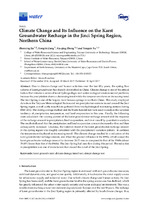| dc.contributor.author | Jia, Zhenxing | |
| dc.contributor.author | Zang, Hongfei | |
| dc.contributor.author | Zheng, Xiuqing | |
| dc.contributor.author | Xu, Yongxin | |
| dc.date.accessioned | 2017-04-22T10:01:55Z | |
| dc.date.available | 2017-04-22T10:01:55Z | |
| dc.date.issued | 2017 | |
| dc.identifier.citation | Jia, Z. et al. (2017). Climate change and its influence on the Karst groundwater recharge in the Jinci Spring Region, Northern China. Water 9: Art. No. 267 | en_US |
| dc.identifier.issn | 2073-4441 | |
| dc.identifier.uri | http://hdl.handle.net/10566/2748 | |
| dc.identifier.uri | http://dx.doi.org/10.3390/w9040267 | |
| dc.description.abstract | Due to climate change and human activities over the last fifty years, the spring flow
volume of karst groundwater has sharply diminished in China. Climate change is one of the critical
factors that initiates a series of karst hydrogeologic and water ecological environmental problems,
because the precipitation shows a decreasing trend while the temperature shows an increasing trend.
The Jinci Spring is one of the largest, most famous springs in northern China. This study employed
data from the Taiyuan Meteorological Station and ten precipitation stations in and around the Jinci
Spring region as well as the runoff data gathered from two hydrological monitoring stations during
1960-2012. The sliding average method and the Mann-Kendall test were used to analyze the variation
tendency of precipitation, temperature, and land evaporation in this area. Finally, the following
were calculated: the varying pattern of the karst groundwater recharge amount and the response
of the recharge amount to precipitation, land evaporation, and river runoff by quantitative analysis.
The results indicated that the precipitation and land evaporation amount decreased at first and then
subsequently increased. Likewise, the variation trend of the karst groundwater recharge amount
in the spring region was roughly consistent with the precipitation variation pattern. In contrast,
the temperature displayed an increasing trend. The climate change resulted in a reduction of the
karst groundwater recharge amount, and it had the greatest influence in the 1990s, which caused the
karst groundwater recharge amount to decrease 26.75 mm as compared to that of the 1960s (about
39.68% lower than that of the 1960s). The Jinci Spring had zero flow during this period. The reduction
in precipitation was one of main factors that caused the cutoff of the Jinci Spring. | en_US |
| dc.language.iso | en | en_US |
| dc.publisher | MDPI | en_US |
| dc.rights | © 2017 by the authors; licensee MDPI, Basel, Switzerland. This article is an open access article distributed under the terms and conditions of the Creative Commons Attribution License (http://creativecommons.org/licenses/by/4.0/). | |
| dc.subject | Karst groundwater | en_US |
| dc.subject | Climate change | en_US |
| dc.subject | Trend test | en_US |
| dc.subject | Abrupt change test | en_US |
| dc.title | Climate change and its influence on the Karst groundwater recharge in the Jinci Spring Region, Northern China | en_US |
| dc.type | Article | en_US |
| dc.privacy.showsubmitter | FALSE | |
| dc.status.ispeerreviewed | TRUE | |
| dc.description.accreditation | ISI | en_US |

